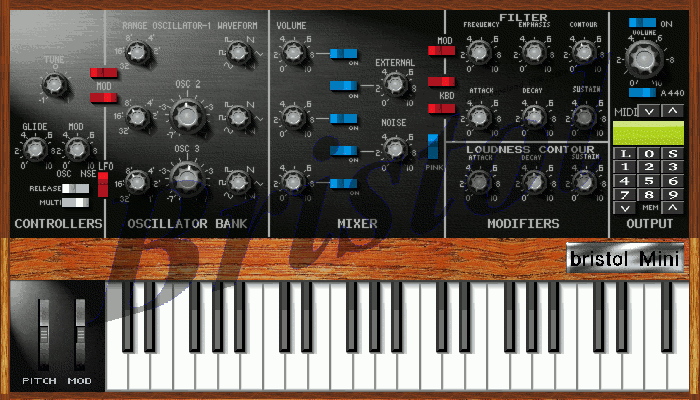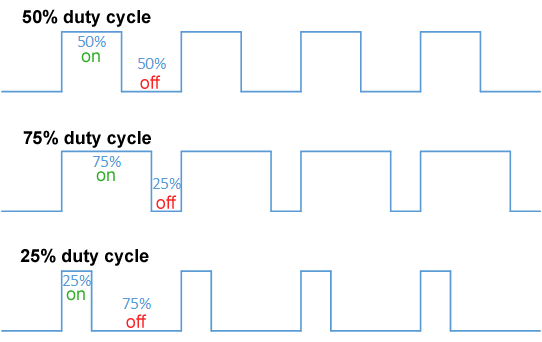|
Phase Offset Modulation
Phase offset modulation works by overlaying two instances of a periodic waveform on top of each other. (In software synthesis, the waveform is usually generated by using a lookup table.) The two instances of the waveform are kept slightly out of sync with each other, as one is further ahead or further behind in its cycle. The values of both of the waveforms are either multiplied together, or the value of one is subtracted from the other. This generates an entirely new waveform with a drastically different shape. For example, one sawtooth (ramp) wave subtracted from another will create a pulse wave, with the amount of offset (i.e. the difference between the two waveforms' starting points) dictating the duty cycle. If you slowly change the offset amount, you create pulse-width modulation Pulse-width modulation (PWM), also known as pulse-duration modulation (PDM) or pulse-length modulation (PLM), is any method of representing a signal as a rectangular wave with a varyi ... [...More Info...] [...Related Items...] OR: [Wikipedia] [Google] [Baidu] [Amazon] |
Waveform
In electronics, acoustics, and related fields, the waveform of a signal is the shape of its Graph of a function, graph as a function of time, independent of its time and Magnitude (mathematics), magnitude Scale (ratio), scales and of any displacement in time.David Crecraft, David Gorham, ''Electronics'', 2nd ed., , CRC Press, 2002, p. 62 ''Periodic waveforms'' repeat regularly at a constant wave period, period. The term can also be used for non-periodic or aperiodic signals, like chirps and pulse (signal processing), pulses. In electronics, the term is usually applied to time-varying voltages, electric current, currents, or electromagnetic fields. In acoustics, it is usually applied to steady periodic sounds — variations of air pressure, pressure in air or other media. In these cases, the waveform is an attribute that is independent of the frequency, amplitude, or phase shift of the signal. The waveform of an electrical signal can be visualized with an oscilloscope or an ... [...More Info...] [...Related Items...] OR: [Wikipedia] [Google] [Baidu] [Amazon] |
Software Synthesizer
A software synthesizer or softsynth is a computer program that generates digital audio, usually for music. Computer software that can create sounds or music is not new, but advances in processing speed now allow softsynths to accomplish the same tasks that previously required the dedicated hardware of a conventional synthesizer. Softsynths may be readily interfaced with other music software such as music sequencers typically in the context of a digital audio workstation. Softsynths are usually less expensive and can be more portable than dedicated hardware. Types Softsynths can cover a range of synthesis methods, including subtractive synthesis (including Analog modeling synthesizer, analog modeling, a subtype), FM synthesis (including the similar phase distortion synthesis), physical modelling synthesis, additive synthesis (including the related Additive synthesis#Additive analysis.2Fresynthesis, resynthesis), and sample-based synthesis. Many popular hardware synthesizers are n ... [...More Info...] [...Related Items...] OR: [Wikipedia] [Google] [Baidu] [Amazon] |
Lookup Table
In computer science, a lookup table (LUT) is an array data structure, array that replaces runtime (program lifecycle phase), runtime computation of a mathematical function (mathematics), function with a simpler array indexing operation, in a process termed as ''direct addressing''. The savings in processing time can be significant, because retrieving a value from memory is often faster than carrying out an "expensive" computation or input/output operation. The tables may be precomputation, precalculated and stored in static memory allocation, static program storage, calculated (or prefetcher, "pre-fetched") as part of a program's initialization phase (''memoization''), or even stored in hardware in application-specific platforms. Lookup tables are also used extensively to validate input values by matching against a list of valid (or invalid) items in an array and, in some programming languages, may include pointer functions (or offsets to labels) to process the matching input. Fiel ... [...More Info...] [...Related Items...] OR: [Wikipedia] [Google] [Baidu] [Amazon] |
Sawtooth Wave
The sawtooth wave (or saw wave) is a kind of non-sinusoidal waveform. It is so named based on its resemblance to the teeth of a plain-toothed saw with a zero rake angle. A single sawtooth, or an intermittently triggered sawtooth, is called a ramp waveform. The convention is that a sawtooth wave ramps upward and then sharply drops. In a reverse (or inverse) sawtooth wave, the wave ramps downward and then sharply rises. It can also be considered the extreme case of an asymmetric triangle wave. The equivalent piecewise linear functions x(t) = t - \lfloor t \rfloor x(t) = t \bmod 1 based on the floor function of time ''t'' is an example of a sawtooth wave with period 1. A more general form, in the range −1 to 1, and with period ''p'', is 2\left( - \left\lfloor + \right\rfloor\right) This sawtooth function has the same phase as the sine function. While a square wave is constructed from only odd harmonics, a sawtooth wave's sound is harsh and clear and its spectrum cont ... [...More Info...] [...Related Items...] OR: [Wikipedia] [Google] [Baidu] [Amazon] |
Pulse Wave
A pulse wave or pulse train or rectangular wave is a non-sinusoidal waveform that is the periodic version of the rectangular function. It is held high a percent each cycle ( period) called the duty cycle and for the remainder of each cycle is low. A duty cycle of 50% produces a square wave, a specific case of a rectangular wave. The average level of a rectangular wave is also given by the duty cycle. A pulse wave is used as a basis for other waveforms that modulate an aspect of the pulse wave. In pulse-width modulation (PWM) information is encoded by varying the duty cycle of a pulse wave. Pulse-amplitude modulation (PAM) encodes information by varying the amplitude. Frequency-domain representation The Fourier series expansion for a rectangular pulse wave with period T, amplitude A and pulse length \tau is x(t) = A \frac + \frac \sum_^ \left(\frac \sin\left(\pi n\frac\right) \cos\left(2\pi nft\right)\right) where f = \frac. Equivalently, if duty cycle d = \frac is used, and ... [...More Info...] [...Related Items...] OR: [Wikipedia] [Google] [Baidu] [Amazon] |
Duty Cycle
A duty cycle or power cycle is the fraction of one period in which a signal or system is active. Duty cycle is commonly expressed as a percentage or a ratio. A period is the time it takes for a signal to complete an on-and-off cycle. As a formula, a duty cycle (%) may be expressed as: :D = \frac \times 100\% Equally, a duty cycle (ratio) may be expressed as: :D = \frac where D is the duty cycle, PW is the pulse width (pulse active time), and T is the total period of the signal. Thus, a 60% duty cycle means the signal is on 60% of the time and off 40% of the time. The "on time" for a 60% duty cycle could be a fraction of a second, a day, or even a week, depending on the length of the period. Duty cycles can be used to describe the percent time of an active signal in an electrical device such as the power switch in a switching power supply or the firing of action potentials by a living system such as a neuron. Some publications use \alpha as the symbol for duty cycle. As a ... [...More Info...] [...Related Items...] OR: [Wikipedia] [Google] [Baidu] [Amazon] |
Pulse-width Modulation
Pulse-width modulation (PWM), also known as pulse-duration modulation (PDM) or pulse-length modulation (PLM), is any method of representing a signal as a rectangular wave with a varying duty cycle (and for some methods also a varying period). PWM is useful for controlling the average power or amplitude delivered by an electrical signal. The average value of voltage (and current) fed to the load is controlled by switching the supply between 0 and 100% at a rate faster than it takes the load to change significantly. The longer the switch is on, the higher the total power supplied to the load. Along with maximum power point tracking (MPPT), it is one of the primary methods of controlling the output of solar panels to that which can be utilized by a battery. PWM is particularly suited for running inertial loads such as motors, which are not as easily affected by this discrete switching. The goal of PWM is to control a load; however, the PWM switching frequency must be sele ... [...More Info...] [...Related Items...] OR: [Wikipedia] [Google] [Baidu] [Amazon] |




